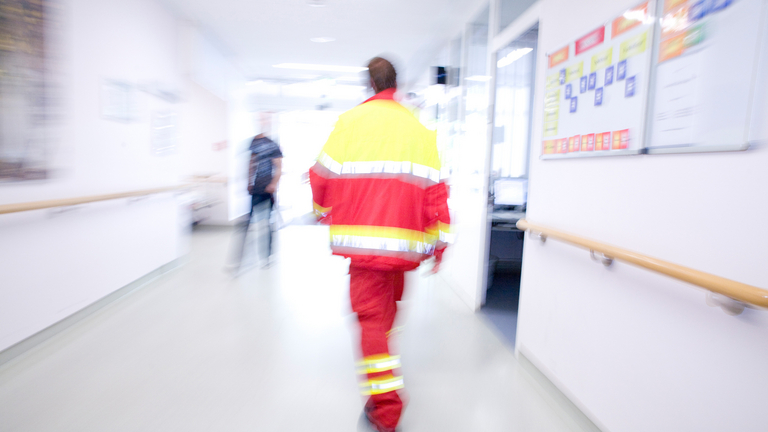
24 hour emergency treatment for acute heart attack
Our hospital's catheterization laboratory is staffed around the clock to provide emergency treatment for patients with acute heart attack (myocardial infarction). This service is provided by our Chest Pain Unit (CPU), which has been certified by the German Cardiac Society (Gesellschaft für Kardiologie).
Contact
What is meant by 24 hour emergency treatment for acute heart attack?
An acute heart attack occurs when there is an interruption in the blood supply to parts of the heart muscle.
As the heart muscle cannot survive for long without oxygen, re-establishing the blood supply to the heart in a timely manner is of crucial importance. Re-opening the affected vessel by mechanical means is not only more effective but also safer than drug-based treatment. As a result, our catheterization laboratory is on standby 24 hours a day in order to offer round-the-clock emergency treatment for patients with acute heart attack.
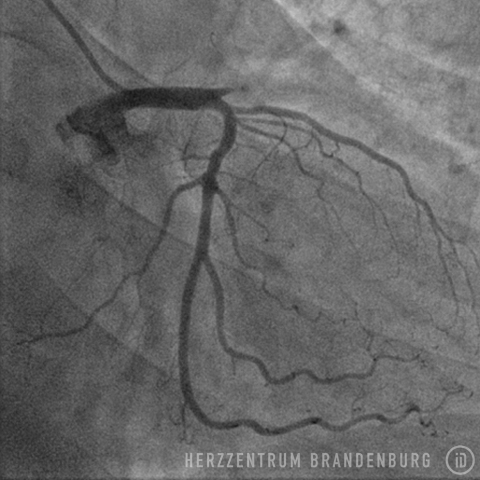
How did 24 hour emergency treatment for heart attack develop?
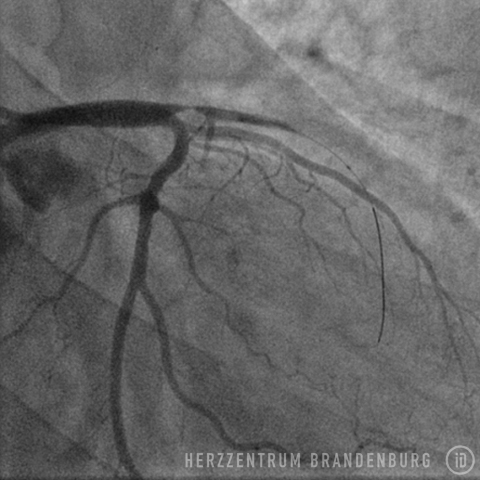
Once Sones had described the process of using contrast agents to visualize the coronary arteries in 1958, it was almost another two decades before Grüntzig became the first person to report on the use of balloon catheters to treat coronary artery stenosis. This was followed in 1979 by Rentrop's description of an innovative approach to the treatment of a patient with acute heart attack.
This treatment involved the use of a guide wire to cross the blood clot inside the coronary artery, followed by the administration of a specific drug to dissolve it.
The following two decades were dominated by research into different thrombolytic substances, which was aimed at establishing their safety and effectiveness in the treatment of heart attacks. Results showed that even the prompt administration of relevant treatment measures did not always succeed in re-opening the affected arteries. Results also revealed that thrombolysis (drug-based treatment to dissolve the blood clot) could lead to complications in relation to the patients' increased propensity to bleed, which resulted in a number of patients suffering brain hemorrhages.
What conditions can be treated by our 24 hour emergency response team?
- Acute heart attack (myocardial infarction) with ST segment elevation, i.e. the ECG trace showing the ST segment as elevated compared to the horizontal baseline (isoelectric line) - an ECG feature characteristic of heart attack
- Acute heart attack (myocardial infarction) without ST segment elevation
- Subacute heart attack (myocardial infarction) in patients with persistent symptoms
- Subacute heart attack (myocardial infarction) in hemodynamically unstable patients
- Cardiac arrest followed by successful resuscitation
How can our 24 hour emergency response team help patients with heart attack?
Cardiac catheterization, balloon angioplasty and stent implantation are performed as described below.
The treatment of acute heart attack centers on measures to restore normal blood supply to the affected area of the heart muscle in a timely manner. Factors affecting how quickly treatment can be started include:
- The amount of time between the start of symptoms and the notification and arrival of emergency services
- The amount of time it takes to reach the hospital
- The amount of time between the patient's arrival at the hospital and successful angioplasty, also known as "door-to-balloon time"
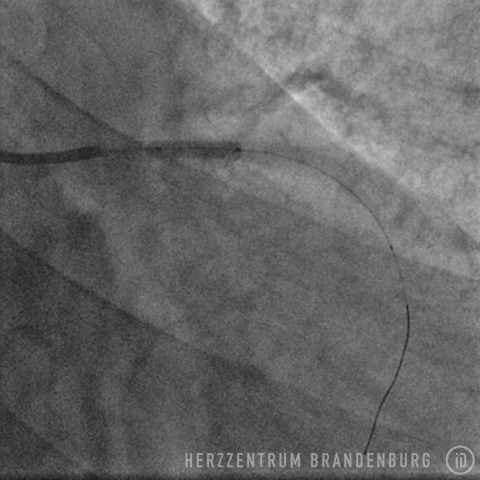
The impact of factors that cause delays in getting a patient to hospital, i.e. the amount of time between the start of symptoms and the notification of emergency services, can be minimized by targeted efforts to increase awareness among the general population. A well-organized cardiac rescue chain - or "chain of survival" - can result in the correct emergency care hospital being chosen from the outset, and a reduction in transit time. In an ideal case scenario, the ambulance team will notify the hospital of the patient's imminent arrival to ensure that the patient can be taken to the catheterization laboratory without delay.
For this reason, our hospital's emergency medical team and the emergency response teams from surrounding districts can transmit ECG data from the ambulance directly to our Cardiology Department. This ensures that our catheterization team can be promptly notified even outside of normal working hours. In addition to a total of three catheterization laboratories that are available during normal working hours to ensure that patients with acute heart attack can receive immediate treatment, we also have a team of physicians and support staff on standby 365 days of the year, who ensure the fastest possible door-to-balloon time.
In 2011, we performed a total of 342 catheterization procedures on patients with acute coronary syndrome. We routinely perform these procedures via the radial artery in the wrist, as this access route is associated with a lower risk of complications than the femoral access route, as well as being associated with improved survival in patients.
What happens when our 24 hour emergency response team treat a patient with acute heart attack?
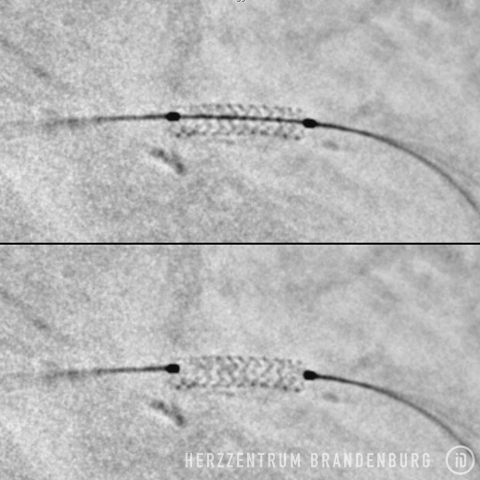
- The patient is positioned on the catheterization table, prepped and draped.
- Wrist and groin are sterilized.
- Nach einer örtlichen Betäubung wird die Arterie mit einer Nadel punktiert.
- Following the application of a local anesthetic, a tiny incision is made in the artery.
- A guide wire is used to introduce a sheath into the artery.
- A catheter is introduced and advanced to the coronary artery.
- A guide wire is used to cross the site of stenosis inside the coronary artery. If necessary, aspiration will be used to remove a blood clot.
- The guide wire is then used to advance a balloon and/or a stent to the site of the stenosis.
- The balloon is inflated and/or the stent expanded.
- Balloon and catheter are removed, and the entry site is dressed with a pressure bandage or closed using a wound closure system.
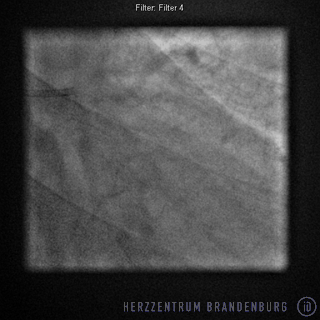
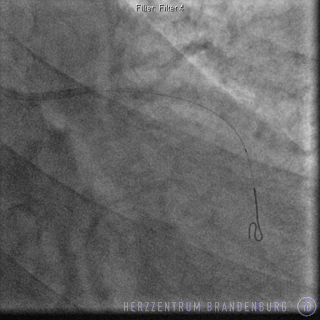
Where can I find out more about 24 hour emergency treatment for acute heart attack?
General information
Deutsche Herzstiftung (German Heart Foundation):
www.herzstiftung.de
General information
Deutsche Gesellschaft für Kardiologie (German Cardiac Society):
www.dgk.org
General information
Patientenfassung der Versorgungsleitlinie [Patient version of the treatment guidelines]:
www.versorgungsleitlinien.de
Specialist publications
- Peterson KL, Nicod P (Hrsg.) Cardiac Catheterization. Methods, Diagnosis, and Therapy. 1st ed. Saunders. Philadelphia, Toronto, Montreal, Sydney, Tokyo. 1997.
- Topol EJ (Hrsg): Textbook of Interventional Cardiology. 5th ed. Saunders, Elsevier. Philadelphia 2008.
- Krakau I: Das Herzkatheterbuch. [The Book of Cardiac Catheterization] Thieme Stutgart, New York 1999
- Ryan TJ. The coronary angiogram and its seminal contributions to cardiovascular medicine over five decades. Trans Am Clin Climatol Assoc. 2002;113:261-71.
- Schömig A, Kastrati A, Dirschinger J et al.: Coronary stenting plus platelet glycoprotein IIb/IIIa blockade compared with tissue plasminogen activator in acute myocardial infarction. Stent versus Thrombolysis for Occluded Coronary Arteries in Patients with Acute Myocardial Infarction Study Investigators. N Engl J Med. 2000 Aug 10;343(6):385-91.
